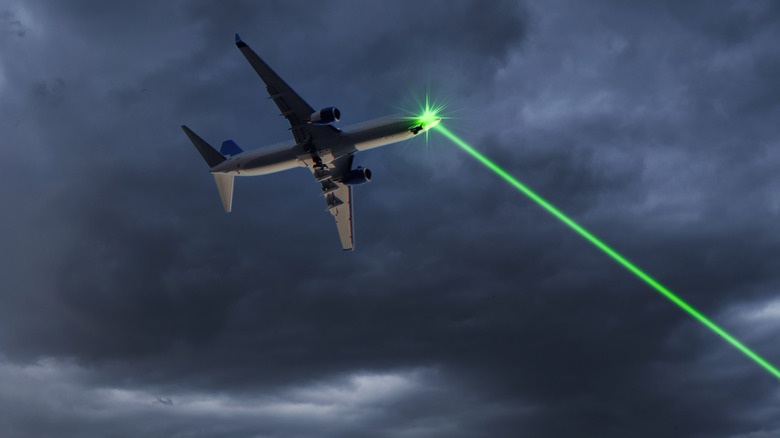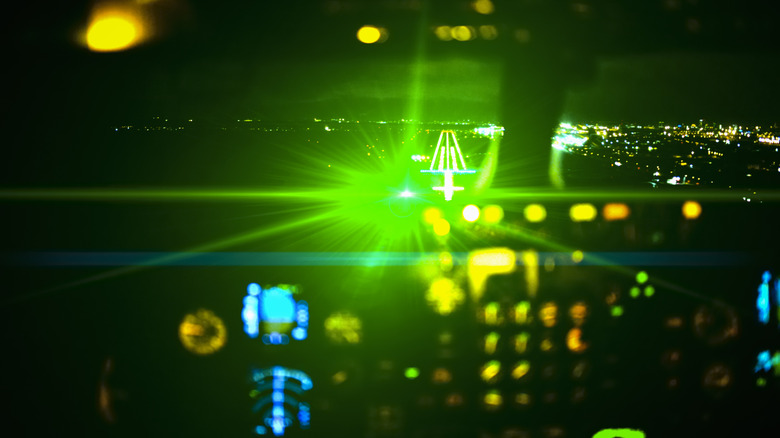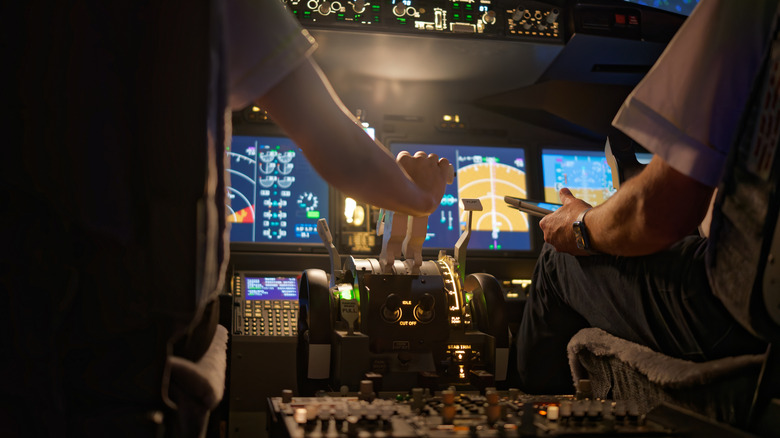Here's Why Laser Pointers Can Be Dangerous For Airplanes
Being an airline pilot is a job of tremendous pressure. It goes without saying, then, that expertise and absolute concentration are paramount. So much so, in fact, that the Federal Aviation Administration's sterile flight deck regulations "prohibit flightcrews from performing nonessential activities during the following phases of flight: taxi, takeoff, landing, and all other flight operations conducted below 10,000 feet, except cruise flight." Absolute concentration is necessary during these critical stages of the flight, and one reason why flying is often considered the safest way to travel. The very last thing that a pilot or crew would need, then, is a laser pointer shining into the cockpit and distracting them.
You might wonder what harm a silly little laser pointer could possibly do to an airplane. That's exactly the issue, though: Many just don't understand how powerful, and how dangerous, these little things can be. Laser pointers can, in actuality, be far stronger than advertised and can damage the skin or vision if not used responsibly. One of the most potentially dangerous things a person can do with one is to point it at an aircraft.
The light from a laser pointer can travel much further than you may have expected. In a February 2014 report on the matter, the FBI noted that a rather standard laser pointer's light can project a mile or more into the sky, dazzling the crew in an aircraft's cockpit. The bureau highlights what a strong and potentially devastating impact that can have on pilots, stating, "Those who have been subject to such attacks have described them as the equivalent of a camera flash going off in a pitch black car at night."
How can a laser do so much damage?
From the ground, a tiny circle of light may be all the operator really sees when pointing a laser at an aircraft. However, the experience in the cockpit is entirely different. FBI Supervisory Special Agent David Gates put it this way: "By the time it reaches the cockpit and the pilot is looking out, that beam of light might be the size of a watermelon or a cantaloupe." This is dangerous enough in and of itself, but there's far worse potential than just that. When our eyes are hit with a sudden bright flash of light, our vision is impaired, and the flash can linger for a time after the light source itself has gone. Gates identified this as flash blindness, an effect caused by cone and rod cells in the retina being overwhelmed by the amount of light all at once. It's particularly dangerous at night, because an affected retina takes longer to recover and adjust in the dark conditions.
The spread of a typical laser pointer's beam means, according to the American Institute of Physics, that "around 100 meters away from a red laser pointer, its beam is about 100 times wider." Furthermore, depending on the point on which a pilot's eyes are focusing when struck by the light, the effect of a laser pointer can vary tremendously in impact and intensity. The study "Laser exposure incidents: Pilot ocular health and aviation safety issues" concluded, per the FAA, that "the energy density of the laser beam can be intensified up to 100,000 times by the focusing action of the eye." Most would probably agree that pilots have more than enough to worry about from natural challenges like extreme weather, without adding laser exposure to the mix.
Lasers, airplanes, and the law
It makes the blood run cold to think of what could happen if one of those laser beams disoriented the flight crew at the worst possible moment. Perhaps the perpetrator of such an act might have thought it was a bit of a joke, but they certainly wouldn't be laughing when the stiff consequences came down upon them. In February 2012, the first federal law forbidding "Aiming a laser pointer at an aircraft" was enacted with exceptions only for those conducting research in an official capacity or "an individual using a laser emergency signaling device to send an emergency distress signal." The penalty is up to five years in prison, a hefty fine, or both.
The FBI has established a $10,000 reward for tips that result in the arrest of anyone caught pointing a laser at an aircraft. Sadly, though, these incidents continue. The Federal Aviation Administration requests that flight crews and members of the public report any laser attacks they witness to them, and the numbers are still alarmingly high: In 2023, 13,304 were reported to the FAA. In 2024, it was 12,840, and as of the time of writing, there have been 5,176 in 2025 so far.
Whether these incidents are grossly irresponsible 'jokes' performed without an understanding of the true dangers or deliberate, targeted attacks, they continue to occur. One important defensive measure for pilots is glasses that can protect them from the glaring reflected light of lasers, and it's vital that the industry continues to develop its measures to keep them safe. After all, while the US Navy has a laser weapon that can shoot down drones, it would be catastrophic if a laser pointer imperiled a civilian aircraft in the same way.


